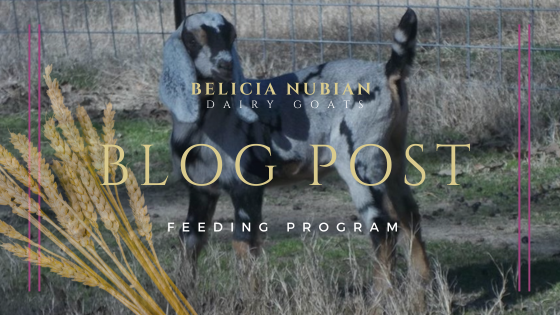Feeding Program
What we Feed
We’ve had numerous customers ask what we feed, so they can purchase similar and transition their goat slowly to a feeding program that works for them.
After raising grand champion horses, we learned early on not to purchase by name brand. We are ingredient readers.
Surprisingly, none of our feed is formulated for goats. What?!?!
With goats being ruminants, most are grazers, like cattle, sheep, llamas and alpacas, but many are foragers similar to deer. Even though people put out feeders to bait deer, their rumens are not designed for a lot of grain. Grain overload with products high in carbohydrates can cause acidosis.
We feed pelleted grain that his higher in fat in an effort to avoid excessive carbohydrate intake. There are a large number of goat farmers who feed products marketed for goats, then add sunflower seeds and beet pulp for a higher amount of fat. We don’t do that.
According to the Merck Manual, protein is required for most normal functions of the body, including maintenance, growth, reproduction, lactation, hair production, and the immune system. Protein deficiencies in the diet deplete stores in the blood, liver, and muscles and predispose animals to a variety of serious and even fatal ailments. Feed intake and dietary digestibility are reduced if dietary crude protein is < 6%, further compounding an energy-protein deficiency; thus, for maintenance of mature, healthy animals, the diet should have a minimum of 7% crude protein. Dietary crude protein requirements are higher for growth, gestation, and lactation.
Most forages contain adequate amounts of dietary protein for maintenance, but lactating, growing, sick, or debilitated animals may require diets fortified with legumes or protein supplements (eg, soybean meal, cottonseed meal, etc). Feeding adequate to slightly greater amounts of protein than required appears to aid in the control (both resistance and resilience) of internal nematode parasites.
We’ve taken those suggestions and found grain that contains 8% fat with a 12% protein and recommended values of selenium, magnesium, iron and zinc. We free-choice, Goat Builder Mineral, made by Ragland® and trace mineral blocks from our local feed mill. We’ve also found our goats like QLF – Liquid Feed Supplements.
Many are not familiar with the higher protein needs of lactating dairy goats. If a young doe kids, she still needs protein for her own growing body and additional for lactation. Dairy goats can grow until they are five. We’ve found studies that vary from 16-30% protein is needed for does in lactation. When our goats are lactating, we supplement higher protein needs with soybean meal and higher fat needs with rice bran. Even then, we will have dam raised triplets and quads that will pull the doe down, even with free-choice grain and liquid feed. This is not uncommon when a 135 lbs Nubian can produce 1749 lbs of milk in a lactation that consists of 4.8% fat and 3.7% protein, according to ADGA breed averages of milk yield and composition. The average fat and protein for Toggenburg is f-3.2%, p-2.7% at the lower end of milk yield and the closest to Nubian is the LaMancha at f-3.9%, p-3.1%. So, just keep in mind that your Nubian will need higher protein, calcium and fat during lactation.
During lactation, we increase calcium levels by feeding alfalfa. Supplementing the legume in pelleted variety is easier for us to store and we do not have as much waist as with heavy string bales.
It seems like every goat group on social media is hardcore with feeding Black Oil Sunflower Seeds – BOSS and Beet Pulp along with a goat brand of feed. Although, we have done extensive research into to Black Oil Sunflower Seeds and have found they can be beneficial to goats with protein, fiber, potassium and iron, it doesn’t do any good when you can’t get your goats to eat them, or they spit them out when chewing their cud. Others may not have this issue, but our drama queens were spitting high-dollar seeds. Beet pulp is a great source of fiber for goats, but for us they are a no, no, NO! We will not feed beet pulp due to choking hazards.
Most of our grain is fed during the lactation period. Our does are only in milk long enough to raise their kids, before weaning them at ninety days. We flush our does when drying them off. They enjoy their summer months on pasture and about a handful of feed to get them to come up so we can make sure everyone is happy and healthy.
We hope our feeding program will help others. We do our best to keep our goats as healthy as possible.

Share this:
- Click to share on Facebook (Opens in new window)
- Click to share on Twitter (Opens in new window)
- Click to share on Tumblr (Opens in new window)
- Click to share on Reddit (Opens in new window)
- Click to share on WhatsApp (Opens in new window)
- Click to share on LinkedIn (Opens in new window)
- Click to share on Pinterest (Opens in new window)
- Click to share on Pocket (Opens in new window)
- Click to share on Telegram (Opens in new window)
- Click to print (Opens in new window)

